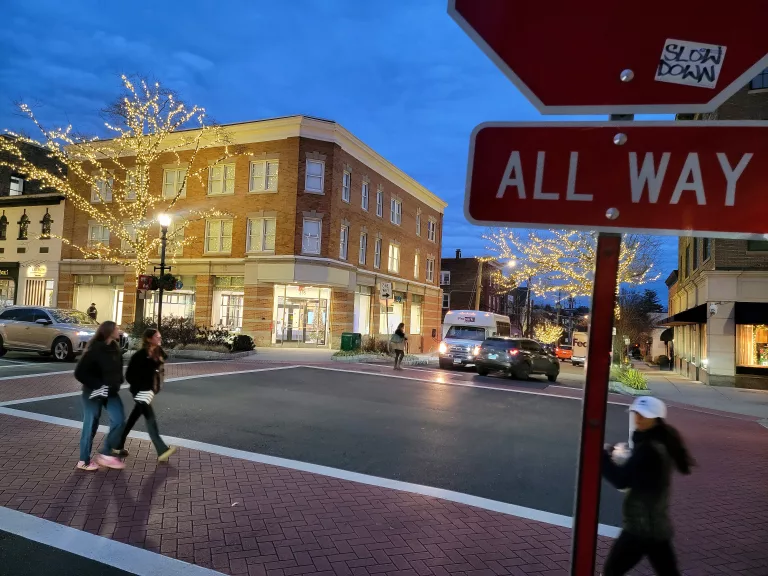

By Anne W. Semmes
Sentinel Columnist
A near miracle of rescue has come to a magical place in Greenwich long beloved by those in the know of one man’s dream made into grand reality—the Greek-fashioned O’Neil amphitheater in a hidden enclave of Cos Cob called Lia Fail. Since 1993, the amphitheater has been listed on the Connecticut State Register of Historic Places. But the registry “does not prevent a property owner from demolishing a building.”
On August 2, the property with amphitheater sold for the second time since the 2011 death of Madelyn O’Neil, widow of the theater’s architect-builder Horton O’Neil. By mid-September, activity on the property told the tale: the new Stamford-based owners, known only as the Nayden Florida Family Trust, had no plan to save the amphitheater. (The 80-year old amphitheater with its history of performance and drama is featured in the Greenwich Library’s Oral History Project.)
What transpired after that discovery by the neighborhood of Lia Fail, of the extraordinary efforts and actions of individuals on the state and local level, working against the clock to save the white marble wonder from the wrecking ball, was the finding of a new home for the amphitheater, in Bronxville, N.Y.
The whistle blower was Florence Phillips, widow of Jack Phillips, brother of Madelyn O’Neil, who lives next door to the amphitheater. Returning from her summer vacation in mid-September she found “massive destruction and clear cutting of all the trees and shrubbery” around the theater. On the advice of another neighbor, Phillips called the Inland Wetlands and Watercourses Agency. The agency, after inspection and finding the owners had no permit for the work being done, put an immediate halt to all action on the property with a cease and restore order.
Phillips also called in longtime Cos Cob friends of hers and the O’Neils, Josie Merck and her husband, New Yorker cartoonist Jim Stevenson. “The unthinkable was occurring,” Merck recalled of the scene. “The amphitheater with its surrounding forest of mature trees was being destroyed.”

Hearing of the destruction, David O’Neil arrived the next day from his Massachusetts home to witness the tree removal and say farewell to the amphitheater built by his late father, Horton, which was inspired by David’s poet grandfather David O’Neil.
“It was so bleak, with all the tree-clearing,” said O’Neil, an architect like his father. “A track vehicle or backhoe had rolled over the stage cracking the marble. “
Horton O’Neil, as in the days of ancient Greece, had hand built the amphitheater to seat 700 along with four workers, including two Italian stonecutters. “Horton designed it when he was 26!” said his son. “He created all that subtlety and refinement. He was a kid! He’d just graduated from architecture school.”
The Lia Fail neighborhood, now galvanized, met to brainstorm how to find a home for the amphitheater—reaching out to schools, organizations, and civic groups that had a campus, and broadening their search to other Connecticut organizations, schools and museums. The fact that the amphitheater was on private property prevented publicizing their efforts.
Calls to the town’s Historic District Commission directed them to the Greenwich Historical Society and its Greenwich Preservation Network, headed by Diane Fox. Fox knew that the Connecticut Trust for Historical Preservation had a “very important circuit rider program with a group that tries to preserve buildings. Called in was Stamford-based circuit rider Wes Haynes, whose job is to check out these historic places and “try to get parties together” to save them.
In early October Haynes made his visit to the amphitheater. His reaction was that he’d seen “the most unusual historic resource” he had encountered in his work with the trust. He promptly got in touch with the property owners to negotiate an agreement to allow the theater to be removed. He was given a deadline of the end of December for the removal—the owners were set on beginning their construction on Jan. 1.
“I thought this was going to be the most impossible assignment I ever had,” said Haynes of the theater’s size and complexity and time frame he was given. His field report on the “O’Neil Outdoor Theater” was duly placed with photos on his website to attract interested parties.
Wanted: Someone or some organization wishing for an amphitheater and able to fund the removal and relocation of some 2,500 marble blocks, a marble stage, and half a dozen marble monoliths, each weighing five tons.
Overtures had gone out to the town. Would it consider removing the amphitheater to the Montgomery Pinetum as it had considered doing 20 years before (so recalled David O’Neil)? “Liability was one of the real restraints,” said Diane Fox of the present queries. “If anyone fell from the marble benches or on the marble steps the town could be sued.”
On Oct. 10 came the watershed moment. Josie Merck, a longtime supporter of her alma mater—Sarah Lawrence College—learned that a college-proposed Barbara Walters Campus Center might include an amphitheater. “There may be a way,” she mused, “to move the theater to Sarah Lawrence.”
Unbeknownst to Merck, Sarah Lawrence was the college of choice for the O’Neil family. Five members of the O’Neil family attended the college, including Horton O’Neil’s sister, Barbara O’Neil, his daughter Joellen O’Neil, his sister-in-law Nina Engel, and her two daughters, Nancy and Nina Washburn.
In late October, two momentous meetings were held at the amphitheater, the first with Haynes, Merck, and three Sarah Lawrence College principals: Stephen Schafer, vice president of Finance and Operations, Ellen Reynolds, interim vice president of Advancement, and architect Pamela Rew, from KSS Architects, who is involved in planning for the college’s future student center. After the meeting, Rew shared her enthusiasm with Merck: “What a great artifact and potential for Sarah Lawrence… If you could describe a dream day for an architect, yesterday would be in the book.”

A week later representatives from the renowned stone work enterprise Ottavino, which had reconstructed the Temple of Dendur for the Metropolitan Museum, arrived with their tools to lift up a couple of marble stones in the amphitheater to see if they were removable. The answer was yes.
Now early November with the clock ticking, Merck was awaiting the removal-relocation estimate from Ottavino while meeting with her Day Pitney team of lawyers, “working under-the-gun on the project” to meet the deadline.
Then came a change from the owners—the estimate needed adjusting. The owners wished to keep 20 percent of the marble seating as well as the stage, to reuse in their landscaping.
But by Thanksgiving Merck had handed over the necessary funds to Sarah Lawrence College, having succeeded in “a remarkably short time,” she noted, to obtain “enthusiastic acceptance from the Sarah Lawrence College president and board, and members of the faculty and staff”—and having handed over to them the arrangements with Ottavino for surveying, removal, storage and cleaning of the approximate 2,000 marble stones for the theater “to be used as an outdoor performance arts theater.”
“My parents would be unbelievably happy to know that the theater was leaving its hidden site, a ‘folly’ in the woods of Cos Cob, to become a part of a public institution, the Common, available to all,” said David O’Neil.
All parties had reached the end of the December deadline. The deadline was then adjusted to the end of March, courtesy of the owners, for the removal of the theater—a job estimated to take three months.
All that is pending now, according to college Vice President Schafer, is a formal site selection on the campus for the amphitheater, and receipt of an approved building permit from the city of Yonkers. “We are working with an architect to obtain recommendations for a suitable site,” he said, “and then will review recommendations for the site location with the college community.”
College President Karen R. Lawrence applauded the Lia Fail property owners’ gift of the “historic amphitheater and alumna Josie Merck’s making the installation on the college’s campus possible.” She cited the gift as “an exemplary commitment to the sustainable reuse of beautiful, natural materials and the preservation of an artistically important structure.” Lawrence noted, “Josie Merck has always been a wonderful friend of the college.”
“It’s wonderful it worked out,” said Wes Haynes. “I didn’t think it would come together. The donor, Josie Merck, is a real hero.” A similar sentiment was expressed by Merck: “Wes Haynes is a hero.”
But for the town of Greenwich, and especially the neighborhood of Lia Fail, Sarah Lawrence College’s gain is their loss. For neighbor Renee Seblatnigg, “The O’Neil Amphitheater was the heart of Lia Fail.”





